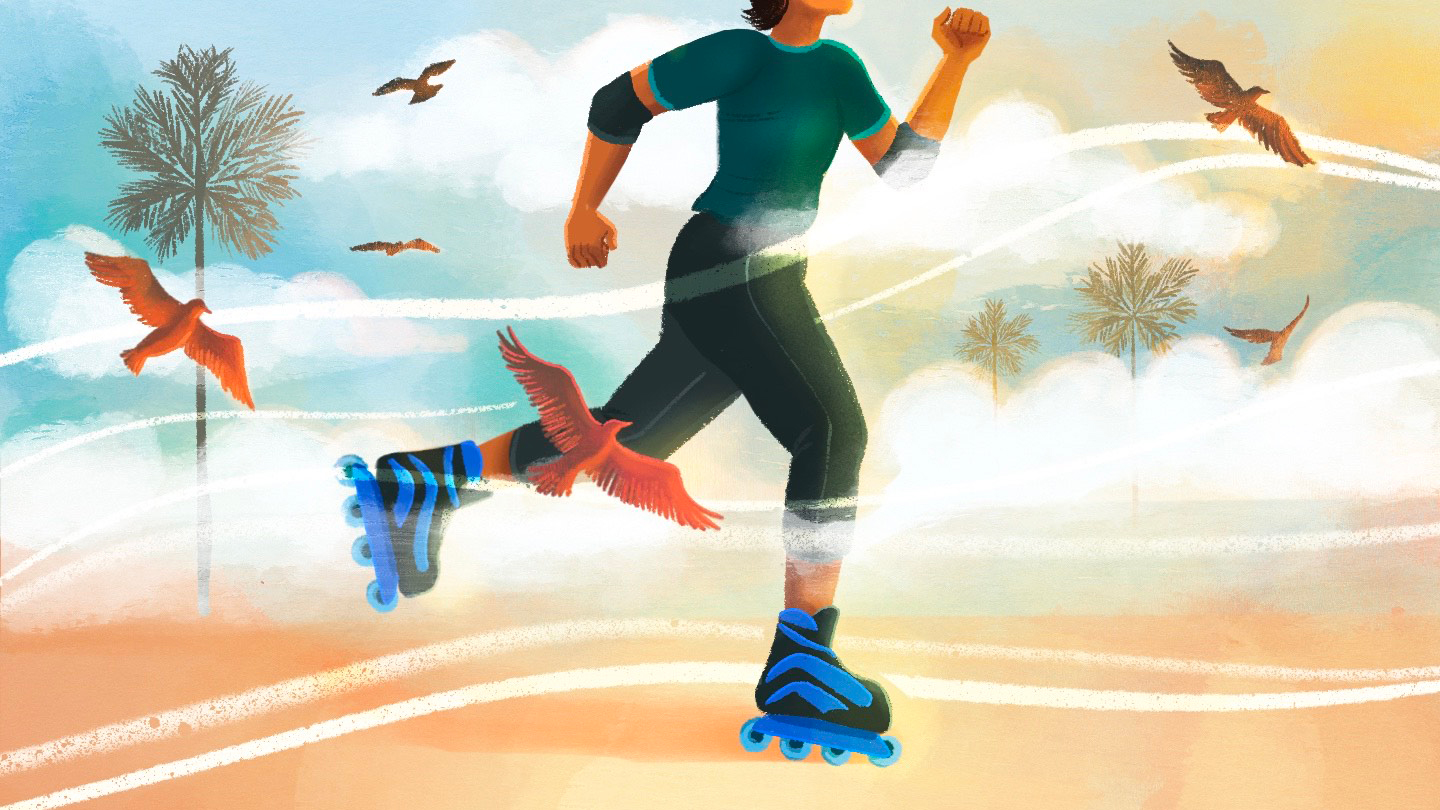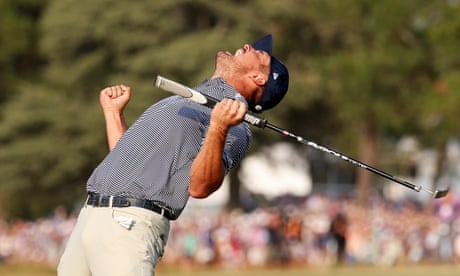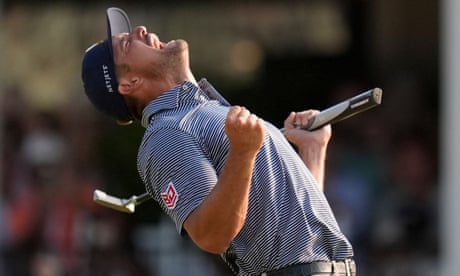
A DIFFERENT KIND OF BELONGING

I
must have been eight years old, and my sense of myself around that time was consumed by watching others, by gauging my surroundings, by trying to fit in. In my memory of those Saturday mornings, I am small, shy and have already been asked by a teacher at school “What are you?” referring to my ethnicity, and so the florescent lighting, the frosty air, the swish of skates, the chop of sticks on the ice, the whack of pucks against the boards — all these reached me with the crack and blaze of something transformative, as I sat in the stands before the break of dawn to watch my six-year-old brother in his first year of organized hockey at the local rink.
My father had brought us to Canada from British Guiana five years previously, fleeing what he saw as a futureless country for his children. He was ambitious, determined that we would be Canadians, and even tried skating himself, but gave it up very quickly after falling and then never letting go of the boards that surrounded the ice. Dutifully and proudly, each Saturday morning between October and April, he woke up his kids in the still-dark morning and dragged us to the local arena, where my brother learned to be part of a team, to become the image of that quintessential Canadian. The most vivid memory I have of those mornings is the angle of skates on the six-year-old boys’ feet — all differing stages of uprightness, their ankles splayed out, the boots of their skates nearly lying flat on the ice as they pushed themselves over the freshly Zambonied surface. My brother’s ankles were the straightest. He seemed made for this sport.
Weekends continued this way, every winter, and while my brother progressed through the years, I attended every game. He skated like something out of my own flying dreams. He glided with his stick and puck through opposing teams with such grace and speed that it looked like dance. Over the years he got better and better, and somehow gentler — even at greater speeds. For several years in a row he was voted the “most gentlemanly player” in his league, the equivalent of the NHL’s Lady Byng Memorial Trophy for sportsmanship.
Only later in our lives did I feel the irony of this award in a sport so systemically brutal. He was dignified, yes, but the players on those other teams had ulterior motives when they hip checked and tripped him to the ice with intention. Their abuse came in calling him the N-word, and often spitting in his face in those close body checks up against the boards. When he, along with others, was plucked out of the Tyke league to play with the Tyke All-Stars, the abuse escalated. The Tyke All-Stars were where most of Toronto’s future NHL players started out. My brother’s gentleness and consistent scoring success in the face of the racial abuse and bullying was worth a trophy indeed, but the violence went unnoticed by the coaches, by most of his teammates. Or if noticed, the unspoken pact of silence made everyone complicit. The brutality was absorbed by my brother’s kind demeanour. He didn’t tell us of this abuse at the time, and amiably accepted the trophies each year. Only recently did he tell me that one of his most persistent abusers is now enshrined in the Hockey Hall of Fame.

Try-outs and team selection to move up the ranks in the leagues, he said, felt discriminatory. He rationalised it at the time, telling himself he just wasn’t good enough, then later resigned himself to the fact that part of becoming good enough meant he had to fight, punch and kick his way through the process, to keep his position as a prized player. When he reached bantam, the discrimination reached its peak. He was benched for an entire year by a coach, once a police officer, who didn’t like him. The next year, under a different coach, my brother won Most Valuable Player.
It doesn’t help my brother’s memories or the grudge he still holds against the Hockey Hall of Fame player, but Hockey Canada has recently started to track on-ice discrimination. According to a recent report, Hockey Canada documented more than 900 alleged incidents of verbal taunts, insults and intimidation in its hockey leagues across all levels and age groups during the 2021-22 season. In a country that prides itself on its equality and diversity, its own national sport is damning.
Willie O’Ree became the NHL’s first Black player in 1958. Currently, 97 per cent of the league’s players are white. The years since O’Ree — and, indeed, my brother — sought to make inroads add up to a lifetime in which things might have been put right. But systemic behaviours are flushed out only with new imaginaries. And new imaginaries are difficult in old structures. Where a sport reigns over imaginations and becomes a symbol of a nation (obliterating others like lacrosse, an Indigenous sport here long before settlers), how does that whole nation hold itself within it?
Still, when I was a child, hockey was something I wanted to belong to. My dad — who faithfully watched Hockey Night in Canada every Saturday evening — was never totally secure as a Canadian, for reasons I also learned of only later in life. Having been racially abused at his job, he tirelessly sought out ways to prove our right to be in the country, taking up skiing at the age of 42 so that he could teach us. I absorbed this pressure and wanted to do my part, so asked him if I could try out for the girls hockey league. By age 11, I had become a strong skater, could spin and skate backwards gracefully on my figure skates, could outskate many of the girls in my school, and felt, in rare moments, that sensation I had while watching my brother: the dreamy flight around obstacles, the swift and steady pursuit of a goal.
But hockey is played on skates without picks at their tips. In my first try-out, all geared up with helmet, mouth guard, gloves and stick, I stepped onto the rink, tried to push off on non-existent picks, and did a slapstick flapping of the arms and can-can kicks to stay upright, but promptly fell on my tailbone, injuring my back and having to remain in bed for the next week. I was so humiliated and despondent to have let my father down that I never again returned to any rink to play hockey.
As I grew, I focussed on other sports. I could run — I was on the track team in high school, a key starting sprinter in the 4 x 100-m. relay. I could jump — I set a record in the high jump at the Ontario finals. I could spike a volleyball — I was captain of our high-school team. In these competitive sports I found myself responding to the need to win in order to belong. I’ve examined this need so exhaustively in my thinking and writing — whether from a racialised standpoint, trying to belong in various white, Black, brown spaces, or from a position of culture, North American, European, Caribbean — the only thing that remains for me to explore is why we need to belong to a team or club or nation at all.

Team sports demand allegiances: they have rules of their own and systems of belief that underlie them. If belonging comes with an ideology, if history is embedded in the entity one claims to belong to, can we ever shake off that baggage, even if it’s toxic? Isn’t learning to be outside those structures, with the potential to remake companionship every day, not also a way to live? I wanted my athletic abilities to give me that feeling of flying over the ice that I saw in my brother, that sense of being so deeply in my body and its connections to the earth that they both melted away. I wanted to find something that allowed me to feel free, and I came to believe the thing that would satisfy that profound thirst did not exist in competition.
In my thirties, I had a devastating breakup with a partner I was living with in Paris, and I returned to live in Montreal. There I longed for an activity to take me out of heartache. I sang Joni Mitchell songs, and wished I had a river I could skate away on. Of course there were ice rinks, and even frozen rivers, but as Caribbean-born I had always only endured winters rather than thrived in them. So that winter was for hibernation, but when summer finally hit, I discovered rollerblading.
In-line skating, or ‘blading’ as I will always call it, took hold of me the way sprinting and high jump had when I was younger. It was like the rink skating I had done as a child before hockey thwarted me, but it could also be done in the expanse of the outdoors. I discovered a trail that ran beside the Lachine Canal, and there I truly felt I had that river to skate away on. I flew. When I was blading, I was inside my body and lost track of time like I do when I write. There was a seamlessness between my blades and the pavement, between my body and the air that I rushed towards. I bladed daily, as a way to recover my life in Canada, and I took my blades with me when I travelled to California with a friend.
The Santa Monica coastline has a dedicated boardwalk where people on wheels soar along in various displays of prowess, speed, costume and style. They spend long, eagle-eyed days exploring or cavorting. At the end of the day they might congregate in circles to talk, practise new moves, learn from each other. Or they might not. There is no team to be a part of. At Venice Beach there were skate parties. The majority of skaters were Black, and their joy sparked in me the thought of other freedoms yet to come. The dancing on skates and blades sometimes defied gravity, often made new forms and inspired in me new images for how to live. Sure, there was competition there too, and I could stay and be a part of it or just soar on down the boardwalk, with very few rules to follow, with no team to feel I could be letting down.
I brought my blades with me when I moved to London and, still today, at the path that circles The Serpentine in Hyde Park, I sometimes join in with the skaters doing zigzags around cones set out to challenge them; watch in awe as they do the circuit on one foot or backwards. I try to emulate them, or just skate past, my arms outstretched, wishing.
Imagine. What might it be for a young person who just wants to soar on ice, or through water, on the court or on the track, not to face barriers to sport from institutions and structures that have been designed to keep them out? Imagine. Which halls of fame for the young people like my brother who survive the brutality of the game they love?
On blades I found a different kind of belonging. To the pulse. Not the win.
Illustrations by Chelsea Charles




